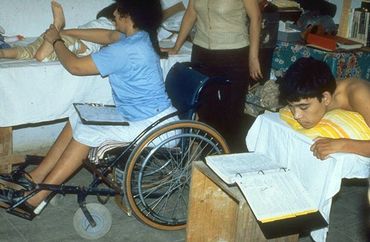Hesperian Health Guides
Helping the Child and Family Adjust
HealthWiki > Disabled Village Children > Chapter 23: Spinal Cord Injury > Helping the Child and Family Adjust
Perhaps the biggest difference from spina bifida is that spinal cord injury begins later. One day the child is physically active and able, the next he is suddenly paralyzed and (at first) unable to do much for himself. He has lost all feeling and control in part of his body; it is like a dead weight.
This is very hard for the child—and family—to accept. Both have an enormous fear and uncertainty about the future. The child may become deeply depressed, or angry and uncooperative. He may refuse even to sit in a wheelchair because this means accepting not being able to walk.
There are no easy answers to the child’s fear and depression, but here are some suggestions families have found helpful.
- Recognize that the child’s fear, depression, and anger are natural responses and that with love, understanding and encouragement, he will little by little overcome them.
- Be honest to the child about her disability. Do not tell her, “We will find a cure for you,” or, “Soon you will get well and be able to walk again.” Very probably this is not true, and telling the child such things only makes it more difficult for the child to accept her disability and to begin shaping a new life. Also, as the promised ‘cure’ fails to happen, the child becomes more uncertain, distrustful, and afraid. In the end, it will be much easier for her if you gently tell the truth. Here is one example.

other important things you will need to learn first—
like sitting up and
finding other ways
to move about.
- Provide opportunities to keep the child’s mind active: playing, working, exploring, learning through stories, games, and studies. But at the same time respect and be supportive of the child when he feels sad and frightened. Let him cry, comfort him when he does, but do not tell him not to cry. Crying helps relieve fear and tension.
- Start the child with exercises, activities, and relearning to use her hands and body as soon as possible. Start with what the child can do, and build on that.
 |
| Look for ways to people with spinal cord injuries learn skills and play a useful, helpful role. Here 2 young people with spinal cord injuries in PROJIMO examine a child with disabilities, and give recommendations to the family, using an early draft of this book. |
- Try to have the child watch, talk with, and get to know other persons with spinal cord injury (or children with spina bifida), especially those who are living full and happy lives.
- Invite the child’s friends to come visit her, play with her, and let her know that they are eager for the day she will be back in school.
- Encourage the child to do as much for herself as possible. Let her do anything she can do for herself—even if it takes longer.
- As much as possible, avoid ‘tranquilizers’ or other strong medicines. The child needs an alert mind and an ability to move actively all day.
Help in ways that let the child do more for herself.


